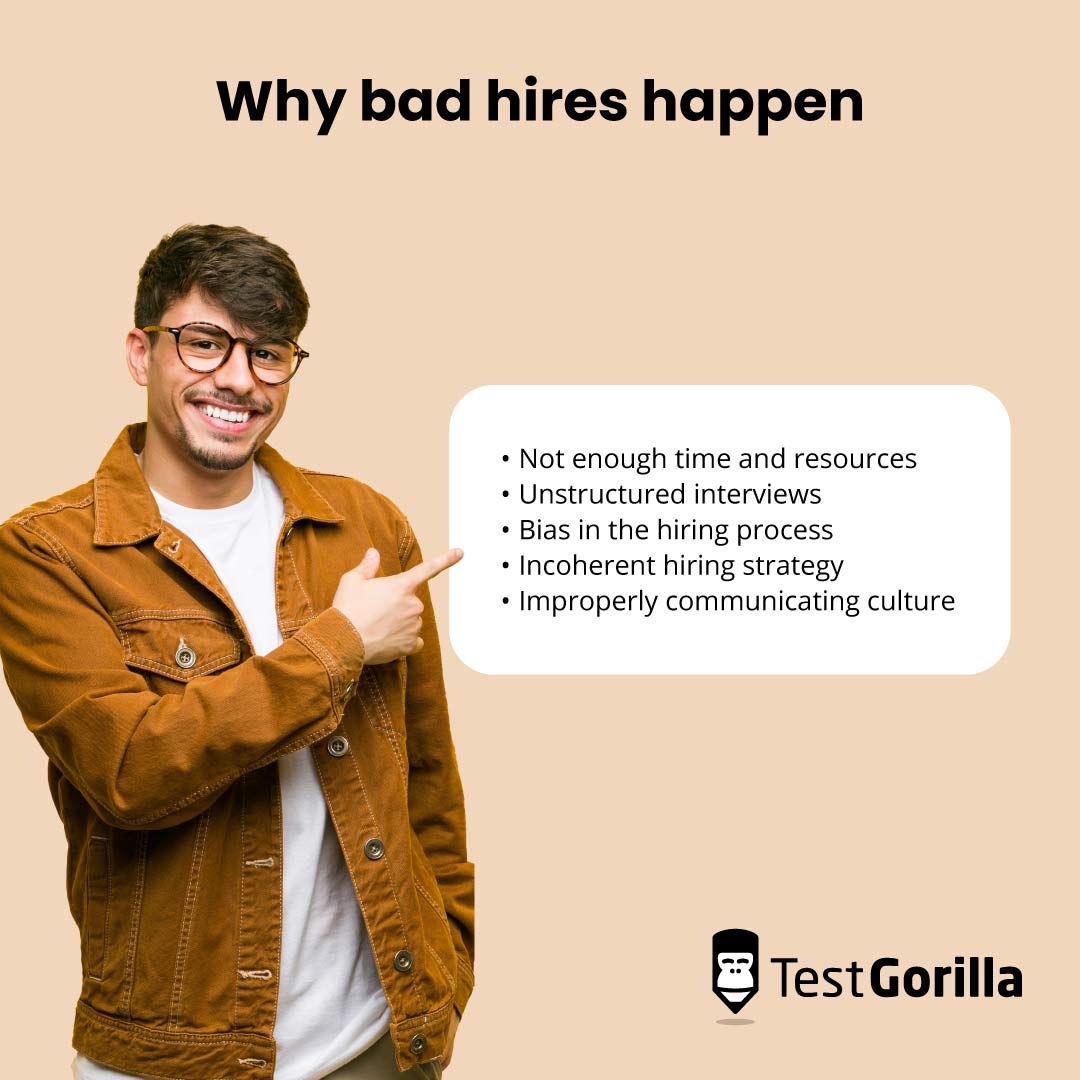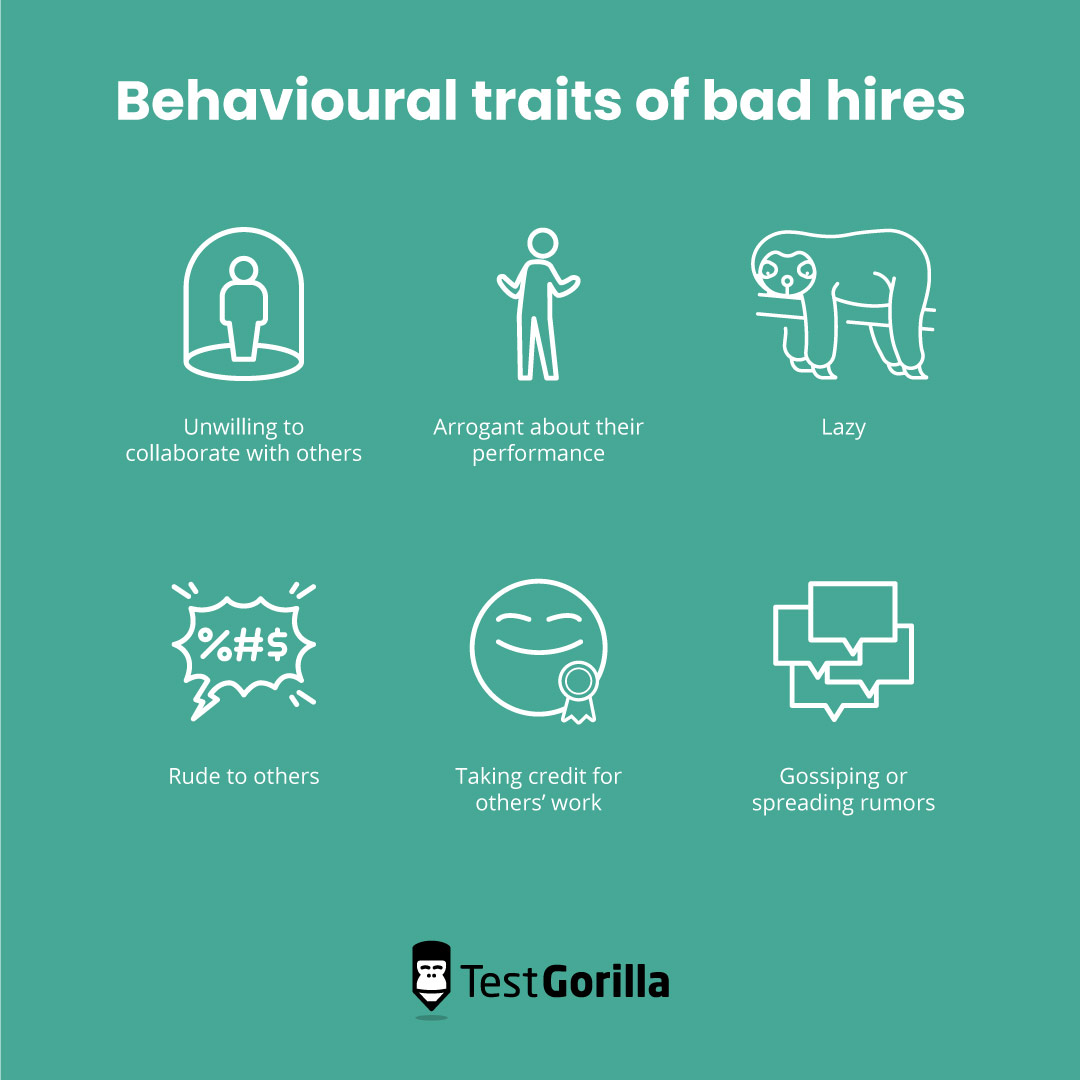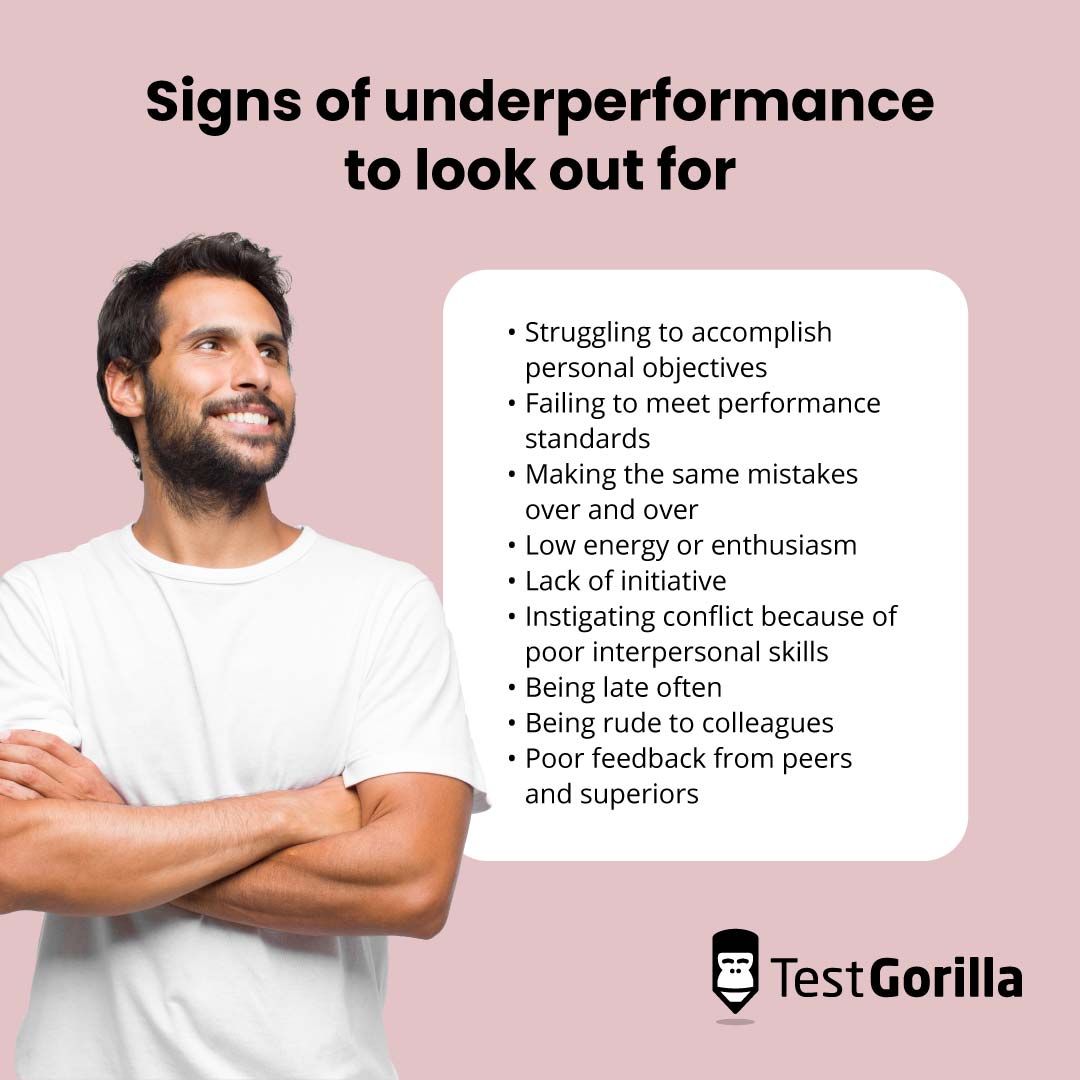Every employer has been there.
You find a candidate that checks off every box during the hiring process: timely, responsive, organized, curious, and capable of excelling.
But once they start work, things aren’t working out.
The new hire lacks the skills you thought they had, they’re late on assignments, or they have a negative attitude.
Time to face the facts. You made a bad hire. Only 19% of new hires are unequivocally successful.[1]
Skills-based hiring practices help you hire the right person next time.
But what about the bad hire you just made? Skills-based hiring also has you covered.
The answer isn’t always as simple as firing a bad hire. You don’t have to be stuck with one.
This guide will show you the signs of a bad hire, how to prevent it, and more importantly, what you can do after making a bad hire.
Table of contents
Why do bad hires happen?
No employer or hiring manager wants to make a bad hire.
But since bad hires are unfortunate facts in every industry, it’s important to know why they happen.
Traditional hiring practices that do not accurately assess a candidate’s hard and soft skills, personality attributes, and willingness to learn usually result in a bad hire.
Bad hires happen because of:
Not enough time and resources: You rush the hiring process and don’t assess skills properly.
Unstructured interviews: You judge candidates based on first impressions and imprecise metrics in free-flowing, subjective interviews instead of assessing them for skills and competencies.
Bias in the hiring process: You hire candidates because of the interviewer’s different biases instead of the candidate’s ability to perform well in the role. Unconscious bias, for example, is when a recruiter or hiring manager relies on their gut instinct or makes a snap judgment about a candidate without even noticing.
Incoherent hiring strategy: There is a lack of communication between recruiter and employer and a lack of communication between hiring manager and candidate. You don’t have firm hiring goals and didn’t perform a skills-gap analysis.
Improperly communicating culture: You assume the candidate is aligned with your culture without using tests like the Culture Add test to understand their values and motivations. Hiring for culture fit leads to groupthink, and if your new hire doesn’t adhere to the status quo, they could underperform in your organizational structure.
How bad hires impact your organization
According to the US Department of Labor, the average cost of a bad hire is roughly 30% of that employee’s first-year earnings.[2]
These costs are related to the time, resources, and energy spent:
Onboarding and training a new hire
Reviewing resumes and interviewing candidates
Managing poor performance
Making up for lost productivity
Moreover, a bad hire can drain morale and increase organizational stress. The other unseen, personal costs of a bad hire, like the negative impact on your client relationships, company culture, and workplace communication, are equally bad.
A bad hire can be more than someone who doesn’t work well or finish projects on time.
They can make your organization a difficult and unsatisfying place to work.
The best insights on HR and recruitment, delivered to your inbox.
Biweekly updates. No spam. Unsubscribe any time.
5 signs you have made a bad hire
A bad hire isn’t always apparent right away. According to a study by Robert Half, 39% of employers typically realize within two weeks that they have made a bad hire.[3]
It can take a few days or weeks to determine whether a candidate is still getting a feel for their new role or is harming your organization, either with their behavior, productivity level, or lack of skills.
Here are 5 red flags to watch out for.
1. Underperformance
If your new hire constantly misses deadlines, delivers sub-par results, fails to complete basic tasks, or ignores responsibilities, you have a bad hire on your hands.
Recognizing underperformance is crucial to learning if you’ve made a bad hire. Some signs of underperformance are:
Struggling to accomplish personal objectives
Failing to meet performance standards
Making the same mistakes over and over
Low energy or enthusiasm
Lack of initiative
Instigating conflict because of poor interpersonal skills
Being late often
Being rude to colleagues
Poor feedback from peers and superiors
With 89% of hiring executives saying bad hires often lack skills, it’s easy to believe that a bad hire is someone lacking technical skills or not getting their work done on time.
But underperformance is also related to an array of interpersonal deficits that a bad hire reveals the more they interact with your organization.
2. High stress levels
Is your new hire constantly stressed out?
A high stress level doesn’t automatically mean that they are a bad hire. Roughly 80% of US workers suffer from work-related stress, and 25% say their job is the biggest stressor in their lives.
But if your candidate is consistently and visibly stressed whenever they have a new challenge or responsibility, you may have made the wrong hiring choice.
If that stress level is impeding your workflow and organizational progress, it’s pretty clear they are not fit for the role.
Stress is contagious. Your bad hire could be stressing your good hires, which can decrease team morale and productivity.
3. Bad attitude
Is your new worker complaining a lot? Are they disparaging other employees or managers? A negative attitude is a telltale sign of a bad hire.
If you sense your new hire has a bad attitude, it could also be because of high stress levels. Nearly three in five employees have experienced negative impacts of work-related stress:
Lack of interest, motivation, and energy (26%)
Trouble focusing (21%)
Lack of effort (19%)
But there’s a difference between a new hire who is struggling to stay engaged and a bad hire who is:
Unwilling to collaborate with others
Arrogant about their performance
Lazy
Rude to others
Taking credit for others’ work
Gossiping or spreading rumors
If these behaviors start to surface, don’t ignore them. They can cost your organization time, resources, and job satisfaction.
4. Untrustworthy
What happened to the charming, patient, and kind candidate you met in the interview?
Unfortunately, it’s not unheard of for a candidate to present themself in a positive light during the hiring process, only to reveal the opposite once hired.
Take this situation, for example:
Although this example is rather extreme, it’s not unheard of. Traditional hiring practices that rely on degrees, resumes, and unstructured interviews to gauge a candidate’s fit with your organization increase the risk of a bad hire.
That’s because they don’t measure skills, personality, or situational judgment.
There are plenty of resume recruiting horror stories that support this.
Although you can’t always prevent a candidate from stretching the truth, trust is crucial in the workplace. If your new hire already shows that they are untrustworthy, it may be time to move on.
5. Damaging productivity and morale
The negative impacts of a bad hire often go beyond that one worker.
If your new hire is holding up projects, disrupting workflows, and making it difficult for your workplace to function, your bad hire is affecting your good hires.
Boosting morale at work is crucial to employee productivity and organizational success because it:
Improves work quality and efficiency
Increases job satisfaction and reduces turnover
Reduces worker burnout
Building a positive work environment and boosting morale takes time and effort. If a new employee is threatening the work you’ve put in to create a healthy workplace, they’re a bad hire.
How to prevent a bad hire
Our report, The State of Skills-Based Hiring 2022 found that 92.5% of organizations saw a reduction in mis-hires when implementing skills-based hiring practices.
Skills-based hiring uses multi-measure pre-employment testing to gain objective results about a candidate’s skills, character traits, and growth potential.
For example, instead of taking a candidate at their word regarding their customer service skills, you should try our Customer Service test that evaluates a candidate’s understanding of:
Customer inquiries and root causes
How to solve problems accurately and efficiently
Appropriate language and attitude with customers
How to improve customer satisfaction.
Don’t rely on your first impression of a candidate to gauge their personality.
As we have seen, a candidate who interviews well but has a bad attitude or combative personality can damage morale and productivity.
Use personality tests like our 16 Personalities test to pinpoint candidates’ preferences, personality traits, and how they approach issues and opportunities.
What if a candidate has proven their skills with skills tests and has a personality that meshes well with your organization, but you’re still unconvinced that they would make a great hire?
Skills-based hiring uses metrics like behavioral interviews and situational judgment tests to assess behavioral skills and a candidate’s response to work-related questions.
Curious about how to implement skills-based hiring in your organization? Adopt these best practices to attract, locate, and retain top-tier talent and avoid bad hires.
What to do when a bad hire slips through the cracks
Skills-based hiring practices are a great way to avoid a mis-hire, but what if you’ve already made a bad hire?
These practices also help when a bad hire slips through the cracks.
Just because you’ve made a bad hire doesn’t mean you must live with the mistake.
Workers are human beings with complex lives and personalities, all of which could be contributing to their poor performance.
As an employer, you can take meaningful steps to rehabilitate a bad hire.
Let’s explore some easy tips to help improve a new hire’s performance or, if it gets to that point, guide your layoff process.
1. Identify the problem
A bad hire isn’t always obvious. Maybe your new hire is standoffish but delivers excellent presentations. That doesn’t necessarily mean they are a bad hire.
It’s important to remember that there are layers to each individual, and it’s your responsibility as an employer to determine whether a new hire is not what you expected or is bad for your business.
Ask yourself: What is my hire doing that has me questioning their performance?
Ensure you consult with your managers and team leaders to get a fuller picture of how your new hire is performing and where the problem is.
2. Be direct
If you have been aware of your new hire’s poor performance, you must have already tried multiple ways to support them.
But there comes a time when polite reminders and hand-holding aren’t enough to fix the problem.
When it’s time to have the big conversation regarding how your new hire adds to the company, show your dissatisfaction.
If there is any hope of resolving the issue, there needs to be a clear line of communication from the outset.
Maintaining healthy workplace communication requires consistency and clarity from the top down.
However, feedback should never be a one-way street where the employer or manager does all the talking.
It is the company’s responsibility to lead by example and communicate its desire to identify the issues, offer fixes to problems, and establish a way forward.
Being direct isn’t calling someone out. It’s calling attention to a problem and figuring out how to solve it.
3. Listen to feedback
Listening to feedback doesn’t mean you have to accept negative employee attitudes as a necessary evil.
But listening to employee feedback enables the new hire to provide context for their behavior and poor performance.
Maybe they are missing deadlines because they have insomnia and are unable to keep track of assignments owing to a lack of sleep.
Maybe the candidate is highly stressed because they are a new parent and need time to adjust.
Is it possible that your workplace is not as diverse and inclusive as you thought?
Perhaps a new hire is acting combative because they are experiencing discrimination in the workplace, which takes a mental toll on the brain, or are attempting to challenge the status quo with little effect.
The fastest way to reach an effective resolution with your bad hire, whether rehabilitation or firing, is by listening to their perspective before deciding.
These conversations can be uncomfortable, but they need to happen.
4. Try to rehabilitate the hire with upskilling or reskilling
It’s important to consider whether a candidate doesn’t have the skills for a role, isn’t interested in it, or both.
Is your new hire suddenly slacking off because they can’t do the work or because the work does not make the best use of their skills?
To answer these questions, employee engagement becomes crucial.
Employee engagement makes the difference between a team that just gets the work done and a team that’s driving your organizational success.
Upskilling and reskilling play large roles in keeping your workers engaged. They’re also a great tool to turn a seemingly bad hire into a top performer in the right role and with skills training.
Upskilling is when you give employees training opportunities to build upon their existing skills to improve engagement and performance in their current roles.
Reskilling is when you teach workers new skills to transfer them to a new role or fill an organizational gap.
Follow these steps to upskill your employees:
Upskilling step | How it works |
Conduct a | An HR method used to compare your hire’s existing skills with the skills needed to perform in the role |
Build a talent map to predict future skills gaps | Forecast your organization’s growth to predict future skills gaps and where your new hire could fall behind |
Identify new hire’s growth potential | is a great way to see where your new hire has the potential to succeed outside of their current skills |
Build a | A plan that contains a new hire’s strengths, areas to improve, required resources, and potential strategies to boost their performance |
Invest in |
These steps only work if your new hire wants to improve.
If they are resistant, it’s probably time to part ways. An unredeemable bad hire finds fault or struggles with any development alternative an employer offers.
Someone in the wrong role who shows promise in other areas usually wants to work with the employer to find the best way forward within your organization.
5. Know when to move on from a bad hire
It’s crucial to look at the impact of your bad hire from all angles and see how you can help them improve.
You could feel partially responsible for the employee’s poor performance and want to make things right.
But if a bad hire has an outsized negative impact on team performance, upskilling, reskilling, and skills training could not be a practical step forward.
This situation can happen when your organization does not have the time or the resources to address your bad hire’s lack of skills or motivation, or they have proven to be a bad actor and a drain on morale.
For example, after hiring a sales representative for your audio software company, you realize they have little to no knowledge or experience working with audio tools.
Your business may not have the time or the resources to provide the hands-on coaching and training that this hire would need to succeed.
There’s also no guarantee that they will respond to training.
Moreover, if they lied about their audio tech skills or are disrupting other employees’ performance, you shouldn’t waste time and resources training them.
If you decide to move on from a bad hire, make it a learning experience.
Ask yourself: Why did I believe this person was suitable? What are the gaps in my hiring process contributing to this bad hire? Could I have identified this bad hire during the hiring process?
Skills-based hiring practices that assess skills, behavioral attributes, and role-specific competencies not only prevent a bad hire but also help you move on from one.
Using tests for your existing team quickly assesses just how far off your hire is from being able to perform.
If your organization can’t afford to start from square one with training, or your new hire refuses to adjust their poor behavior, you can move on.
There are plenty of ways to let go of an employee and remain an attractive workplace.
Use skills-based hiring to avoid and fix a bad hire
Making a bad hire isn’t unusual.
Employers that use traditional hiring practices are especially vulnerable to hiring the wrong person for the job.
Luckily, skills-based hiring can help you avoid a mis-hire or, if you’ve already filled the position, it can help you move forward thoughtfully and effectively.
Skills-based hiring helps you identify skills gaps, assess employee behavior, maintain high team morale, and upskill or reskill new hires that are underperforming but have the potential to improve.
Although bad hires are always possible, traditional hiring practices are ill-equipped to prevent or manage them once they happen.
Read more about why we need a new way to recruit to avoid bad hires and how skills-based hiring can get us there.
Sources
“Why New Hires Fail (The Landmark ‘Hiring For Attitude’ Study Updated With New Data)”. (2020). Leadership IQ. Retrieved May 10, 2023. https://www.leadershipiq.com/blogs/leadershipiq/35354241-why-new-hires-fail-emotional-intelligence-vs-skills
“The Cost of a Bad Hire”. (February 2019). Northwestern Human Resources. Retrieved May 10, 2023. https://hr.northwestern.edu/about/news/february-2019/the-cost-of-a-bad-hire.html
Robert Half. (May 23, 2018). “Two in five businesses realise they’ve hired the wrong candidate within two weeks”. Robert Half Talent Solutions. Retrieved May 10, 2023. https://www.roberthalf.co.uk/press/two-five-businesses-realise-theyve-hired-wrong-candidate-within-two-weeks
You've scrolled this far
Why not try TestGorilla for free, and see what happens when you put skills first.

















